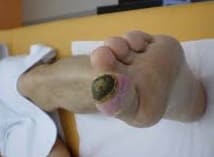In order to know the meaning of the term gangrene, it is necessary, first of all, to discover its etymological origin. Thus, we can emphasize that it derives from Latin, specifically from “gangraena”, which, in turn, emanates from the Greek “gangraina” and which was used as a synonym for the death of tissues and their corresponding putrefaction.
This is what the death of tissue in the absence of blood supply is called.
 Gangrene usually occurs when a wound becomes infected, the cells die and tissue rot occurs. Once gangrene appears, the affected tissues are lost forever (they cannot be recovered).
Gangrene usually occurs when a wound becomes infected, the cells die and tissue rot occurs. Once gangrene appears, the affected tissues are lost forever (they cannot be recovered).
Circulatory problems, diabetes, and open fractures can cause gangrene. If it is internal, the person may experience pain and have a fever. Gangrene of the skin , on the other hand, is revealed by numbness, spots and ulcers.
In order to diagnose gangrene, it is necessary to subject the patient to different tests. Specifically, it will be necessary to carry out everything from a blood test to a blood culture, including an examination of pus. However, it is also common to perform different radiological examinations.
When gangrene breaks out due to lack of blood circulation in a certain area, without another secondary infection, it is called dry gangrene . On the other hand, if gangrene arises as a result of an infection caused by bacteria, it is called wet gangrene . Another type of gangrene is gas or foam gangrene caused by the bacteria Clostridium perfringens , with which the skin falls off in pieces, emanating a nauseating odor.
To prevent the spread of gangrene, in ancient times larvae were used that ate dead flesh and did not affect living tissue. Over the years, antibiotics emerged that make it possible to treat wounds more effectively.
Treatment of gangrene must be urgent. In addition to antibiotics, it may include debridement (the surgical removal of dead tissue) and even amputation of the affected area.
Specifically, among the antibiotics that work the most and best to fight gangrene are Clindamycin, Penicillin , Chloramphenicol and Tetracycline, among others.
Likewise, we cannot ignore other treatments that can be used to address this problem, such as blood vessel surgery, also known as angioplasty, and worm therapy. This, which is also called biological therapy or Maggot therapy, is based on treatments from centuries ago.
Specifically, it consists of the use of worms, which are raised in a special way in laboratories using sterilized eggs. These are placed on the wound in question, covered with gauze and after a few days the aforementioned gauze and said animals are removed. Specifically, what they do is kill bacteria and thus promote a cure.
